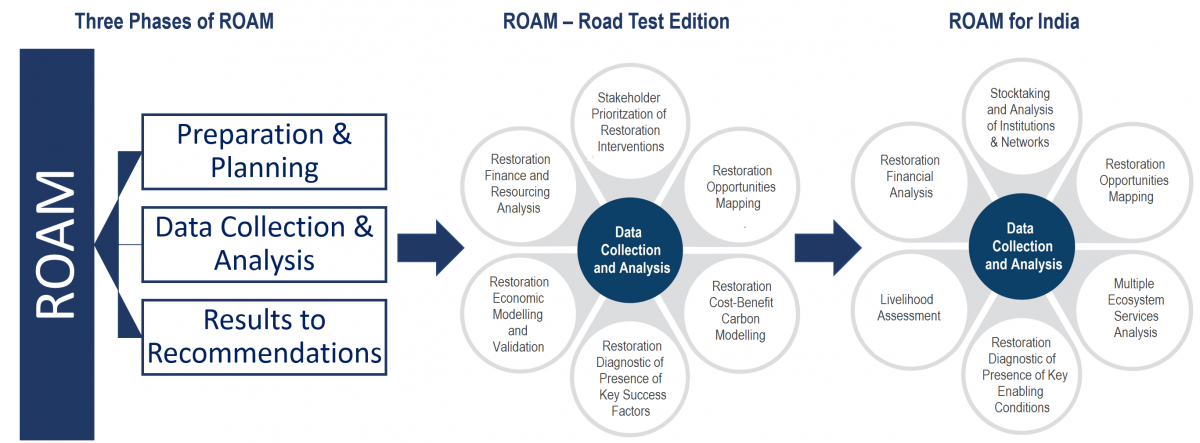
Planning Restoration for India’s Landscapes and Rural Communities
Landscape restoration is the deliberate integration and enhancement of tree cover within different land uses. It comprises a range of interventions including natural regeneration, mixed plantations, and different agroforestry practices. When implemented at scale, landscape restoration can conserve biodiversity, sequester carbon, enhance rural livelihoods and spur rural economy.
India is emerging as a global leader in landscape restoration. The country’s bold commitments include restoring 21 million hectares of deforested and degraded land under the Bonn Challenge, and sequestering an additional 2.5 to 3 billion tons of CO2 equivalent by 2030 through increased forest and tree cover under India’s Nationally Determined Contribution (NDC). Turning these commitments into tangible results requires planning that identifies when, where, how, and with what benefits, tree cover can be increased in different land uses such as forests, agriculture and riparian areas.
The World Resources Institute (WRI) India is adapting the Restoration Opportunities Assessment Methodology (ROAM) for India, to help estimate the potential for landscape restoration across the country. This is based on the original ROAM created by the International Union for the Conservation of Nature (IUCN) and WRI which is now being implemented in over 40 countries worldwide. Consultations and workshops, as well as pilot testing in one district, led to customizations to the data collection and analysis phase of the original ROAM (see Figure 1), including the addition of conceptual enhancements, participatory tools and a resource suite.
 Figure 1: Adapting the ROAM for India
Figure 1: Adapting the ROAM for India
Conceptual enhancements for rural communities
With more than 700 million people in rural India dependent on forests and agriculture for their livelihoods, improved forest and tree cover must meet their priorities, particularly inclusive development. Conceptual enhancements to ROAM therefore underscored not only the environmental objectives and benefits of landscape restoration, but also the development priorities that it can support. This was done through four key additions:
• The policy framework for landscape restoration in India emphasizes ecosystem services that benefit the rural poor, including for women, smallholder farmers, tribal communities and other marginalized groups. These benefits include food security, soil health, water recharge, and the provisioning of fuelwood, non-timber forest produce (NTFP) and fodder. ROAM for India analyses the multiple ecosystem services likely to be generated through landscape restoration and how to manage the synergies and trade-offs between them.
• Forest and tree cover have a direct impact on livelihoods. For instance, the NTFP sector is one of the largest unorganized sectors in India, with an annual turnover of more than USD 800 million, and supports the livelihoods of 250 million people. Consequently, ROAM for India includes a livelihoods assessment which identifies potential value chains and lays out the short, intermediate and long-term benefits that would flow to communities.
• In India, landscape restoration is a sprawling space encompassing a multitude of institutions, networks, stakeholders and their complex connections. The revised component on institutions and networks identifies opportunities to build stronger networks through key nodes, actors and champions who can aid in implementing and scaling landscape restoration.
• ROAM for India integrates questions around crucial foundational factors such as land tenure, governance, gender and social inclusion. For instance, spatial analysis uses land ownership as one of the base layers for identifying restoration opportunity. Legal analysis is incorporated under the enabling conditions component to track the laws and policies that support restoration and identify critical gaps that impede restoration. Gender and social inclusion concerns were addressed by designing data collection methodologies that specifically integrate opinions of women, tribal and other marginalized communities.
Tools for encouraging participation
WRI India developed a set of easy-to-use tools for the different data components of ROAM, to help facilitate stakeholder participation in planning landscape restoration.
• The Rapid Restoration Diagnostic (RRD) is a card game that helps to identify the presence of enabling conditions. It is based on an analysis of 16 case studies across the globe that identify the success factors underpinning restoration.
• The Ecosystem Services Diagnostic is a consultation tool that facilitates stakeholders to identify synergies and trade-offs between the ecosystem services flowing from restoration. This diagnostic is based on IUFRO’s report forest landscape restoration as a key component of climate change mitigation and adaptation.
• ROAM for India also includes Mapathon, an innovative, participatory mapping method that facilitates the involvement of local communities in geospatial analysis. Mapathon combines advanced GIS science and technology with local knowledge and introduces a citizen science approach to ROAM.
Resources and training
WRI India is developing a resource suite for restoration planning based on ROAM and bringing together different tools, resources and methods. Trainings on the resource suite have been conducted for officials from state government departments, forest departments, NABARD, civil society organizations, researchers and land use consultants. As a next step, WRI India is developing a guidebook to enable more users to leverage the resource suite. For more information on the resource suite, please reach out to us at landscapes@wri.org.